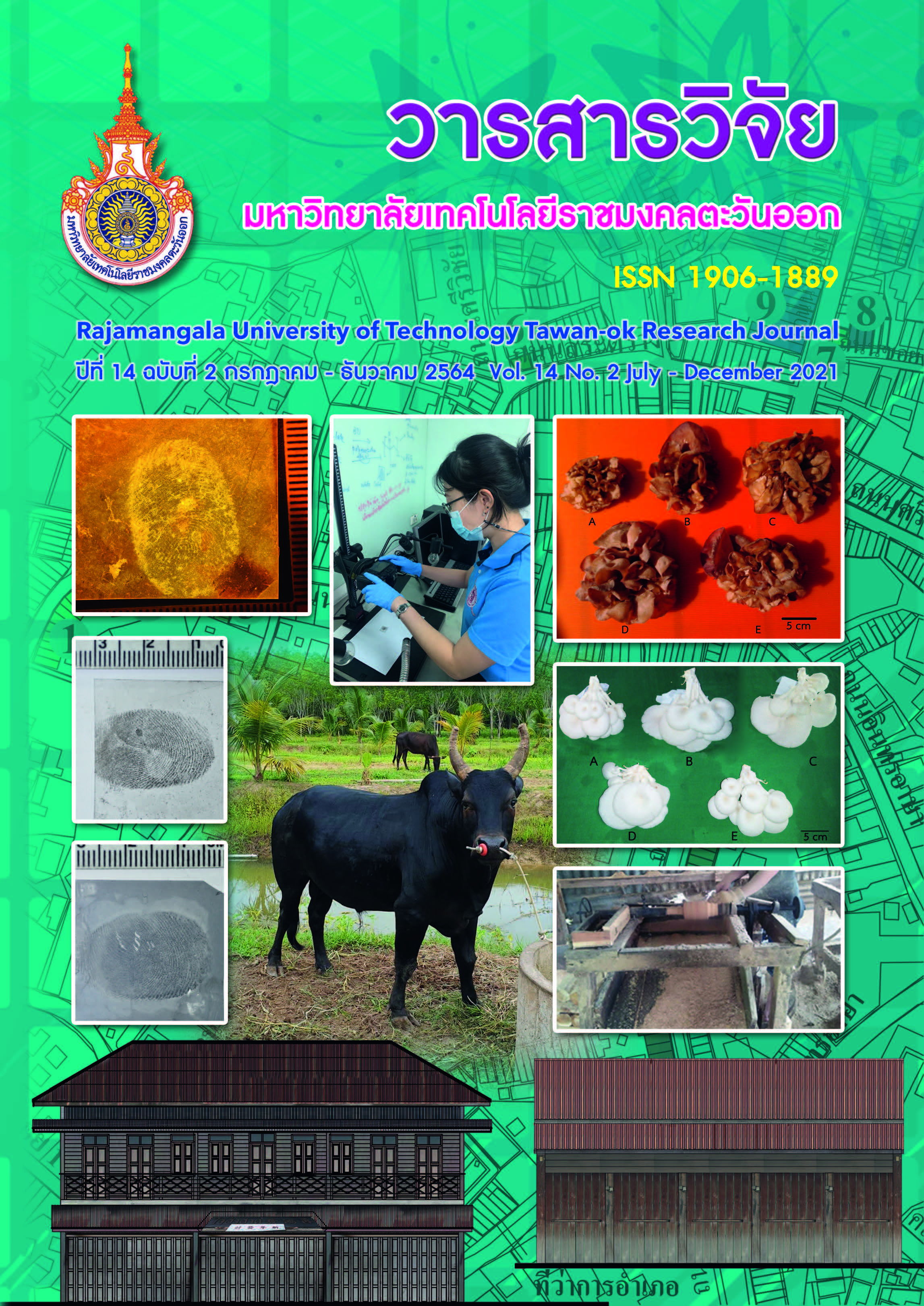Auricularia auricula and Pleurotus ostreatus culture by Leucaena leucocephala sawdust of Java dove’s birdcage waste.
Main Article Content
Abstract
Leucaena leucocephala was important material for Java dove’s craft hook of cage manufacturer. Sawdust was wasted by this process. This research was observed the possibility to using these sawdust to culture two valuable mushrooms: Auricularia auricular, Pleurotus ostreatus by evaluated ratio of Leucaena leucocephala and Hevea brasiliensis sawdust (100:0, 80:20, 50:50, 20:80 และ 0:100, respectively). The mix sawdust was fermented 30 days. The organic chemicals of fermented sawdust were tested before it was packing in 1-kg plastic bag. The result show that pH is 7.9-8.5. Ash, moisture and protein were varies by environment. Mycelium was incubated in dark room at room temperature for 30 days. Next, mushroom harvesting was observed at 30 days and 60 days after mycelium incubation. The growth of two mushrooms were recorded. The ratio mix sawdust was significant difference on fresh weight, size of mushroom of Auricularia auricula. The healthy mushrooms were growth on the ratio of Leucaena leucocephala sawdust more than 50% (the fresh weight is 268 grams/group and size is 15.7 cm.). Whereas the ratio mix sawdust was significant difference on number of mushroom/bag and size of Pleurotus ostreatus, Its healthy growth on the ratio of Leucaena leucocephala sawdust less than 50% (the fresh weight mushroom is 12.7 per bag and size is 10.4 cm.). Therefore Leucaena leucocephala sawdust of Java dove’s cage processed waste can use as material for mushroom spawn culture but the appropriate ratio depends on the kind of mushroom.
Article Details
References
จารุภา ศรีนาค รสสุนธ์ ศรีสุขใจ วาสนา อยู่มั่น และอุรนิตย์ ผาจันทร์. 2555. การเพาะเห็ดนางฟ้าภูฐานด้วยกากใยสับปะรดจากโรงงานทิปโก้ฟูดส์ ประเทศไทย (จำกัด). สาขาชีววิทยา วิทยาศาสตร์บัณฑิต มหาวิทยาลัยเทคโนโลยีราชมงคลธัญบุรี.
จิรพันธุ์ สุขปาละ. 2538. “การเลี้ยงนกเขาชวาลัฒนธรรมที่เกี่ยวข้อง: ศึกษาจากอำเภอจะนะ จังหวัดสงขลา”. ปริญญานิพนธ์ ศิลปศาสตรมหาบัณฑิต สาขาเอกไทยคดีศึกษา บัณฑิตวิทยาลัย. มหาวิทยาลัยศรีนครินทรวิโรฒ สงขลา.
นันทินี ศรีจุมปา และ ศิราการ ขยันการ. 2553. การใช้วัสดุเหลือใช้ทางการเกษตรเพื่อการผลิตเห็ด. วารสารวิชาการเกษตร. 29(2) : 116-118.
นิสาชล กิจพรประเสริฐ. 2557. การวิเคราะห์ต้นทุนและผลตอบแทนของฟาร์มเห็ดขนาดเล็กในอำเภอดอยสะเก็ด จ. เชียงใหม่ บัญชีมหาบัณฑิต บัณฑิตวิทยาลัย. มหาวิทยาลัยเชียงใหม่ จ. เชียงใหม่.
วีรยุทธ กุลพรพันธ์. 2546. กระถิ่นเทพา (Acacia mangium Wild.). สำนักงานบริหารจัดการในพื้นที่ป่าอนุรักษ์ 7. กรมอุทธยานแห่งชาติ สัตว์ป่าและพันธุ์พืช. กรุงเทพ. 40-51.
อัญชลี จาละ. 2557. การใช้ใบไม้และกิ่งไม้หมักเป็นส่วนผสมของขี้เลื่อยไม้ยางพาราในการเพาะเห็ดนางรมภูฏาน. วารสารวิทยาศาสตร์และเทคโนโลยี 22 (4): 501-506.
อัมพร แก้วหนู. 2540. “ภูมิปัญญาท้องถิ่นกับการพัฒนา: พัฒนาได้จริงหรือ?”. วารสารทักษิณคดี 4 (3) สถาบันทักษิณคดีศึกษา. มหาวิทยาลัยทักษิณ.
Kimenju, J.W., G.O.M. Odeo, E.W. Mutitu, P.M. Wachira, R.D. Narla and W.M. Muiru, 2009. Suitability of locally available substrates for oyster mushroom (Pleurotus ostreatus.) cultivation in Kenya. Asian Journal Plant Science 8:510-514.
Narin, R., R.K. Sahu, S. Kumar, S.K. Garg, C.S. Singh and R.S. Kanaujia 2008. Influence of different nitrogen rich supplements during cultivation of Pleurotus florida on maize cobs substrate. Environmentalist, 29:1-7.
Onyango, B.O., V.A .Palapala, P.F.Arama, S.O. Wagai and B.M. Gichimu 2011. Morphological characterization of Kenyan native wood ear mushroom [Auricularia auricular (L. ex Hook.) Underw.] and the effect of supplemented millet and sorghum grians in spawn production. Agriculture and Biology journal of North America. (3): 407-414.
Onyango, B.O., V.A .Palapala, P.F.Arama, S.O. Wagai and B.M. Gichimu 2011. Suitability of Selected Supplemented Substrates of Cultivation of Kenyan A native wood ear mushroom (Auricularia auricular). American Journal of Food Technology 6(5): 395-403.
Pandey, V. K. and M. P. Singh 2014. Biodegradation of wheat straw by Pleurotus ostreatus. Cellular and Molecular Biology 60 (5): 29-34
Royse, D.J. 1997. Specialty mushrooms and their cultivation. Horticultural Reviews 19:59-97.
Staments, P., 2005. Mycelium Running: How Mushrooms Can Help Save the World. Ten Speed Press, Berkeley, CA.


